
|   |

|   |
A befitting guru-dakshina for the ‘demanding guru’ - Shyamhari Chakra e-mail: shyamharichakra@gmail.com Photos: Kaustubh Atre September 11, 2024 For more than half a century, a unique dance festival is being mounted every year in Pune. Popularly known as Gurudakshina Utsav, it was the brain-child of a ‘demanding guru’ who is no more. And yet, the much-awaited annual show goes on every year with utmost enthusiasm hosted by her disciples and the followers of her legacy even 16 years after her passing away. She was Kathak icon Rohini Bhate who hardly needs an introduction to the world of Indian classical dances. A legend during her lifetime – whose year-long birth centenary celebrations are on until November – she was instrumental in introducing classical dance to Maharashtra and developing Pune as an epicentre of Kathak. “Our Guru always insisted on giving gurudakshina not in the materialistic form but in the form of disciples' own creations. This helped generations of students to open up and develop into good choreographers. She used to take the trouble in watching everyone's work prior to putting it up on stage and used to guide and shape up the pieces. Post the stage presentations, she would also sit with all the choreographers and the dancers for a review”, recollected Kathak exponent Neelima Adhye, distinguished disciple of the guru, the current director of Rohini Bhate’s Nrityabharati Kathak Dance Academy in Pune. Continuing with their guru’s vision and Gurudakshina Utsav tradition, Nrityabharati hosted a two-day dance festival on August 20 and 21 at the majestic auditorium of Yashwantrao Chavan Natyagruha featuring fresh productions by 20 choreographers that included nine established Kathak artistes who were direct disciples of the guru and 11 budding choreographers who are disciples of the direct disciples – all followers of the legacy of Guru Rohini Bhate. And the event was aptly titled Anubaddha - committed to follow. The nine seniors – who are also gurus of eminence - were Aabha Wamburkar, Amala Shekhar, Asawaree Patankar, Manjiri Kiran, Maneesha Abhay, Neelima Adhya, Prajakta Raj, Roshan Datye and Rujuta Soman while the young brigade included Abha Auti, Aditi Riswadkar, Ameya Palnitkar, Deepti Thakur Dasai, Dhanashree Natu-Potdar, Kalyani Kulkarni, Mayur Shitole, Shrungali Paranjpe, Siddhi Abhay, Venu Riswadkar and Vidula Walwelkar. The Present Pioneers: Direct disciples of Guru Rohini Bhate 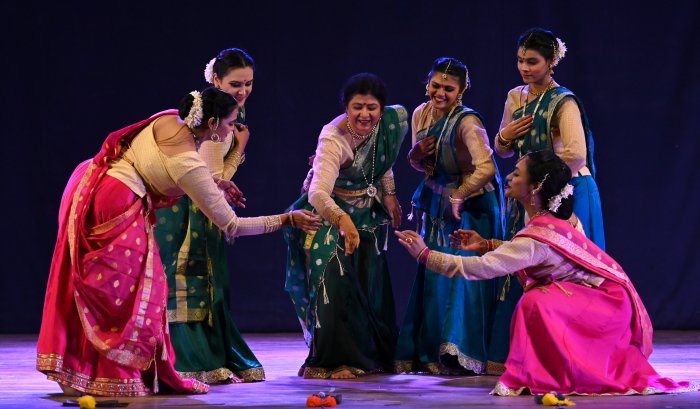 Chaiti Chaiti choreographed by Neelima Adhye, won hearts for its poignant portrayal of the joyful mood that Chaitra – the month of the spring season – brings to the earth and its inhabitants. Chaiti was set to a north Indian folk song that describes the month of Chaitra. Juxtaposed between two contrasting moods – the celebration spirit of the spring and the loneliness of the woman who longs for her man to join her in the celebration – the choreography catered more to the hearts than the heads of the audience and thus stood apart as a class of its own. 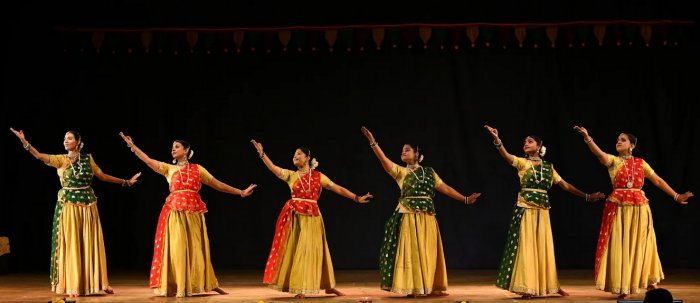 Natwari Tarana Senior disciple of Guru Rohini Bhate, Amala Shekhar, a scholarly guru and choreographer who worked with her guru for more than three decades, staged Natwari Tarana set to raag Sohini followed by Samakshari Abhang. It was a true tribute to her guru and her guru’s guru Pandit Mohanlal Kallianpurkar who were known for their compositions of Samdhun and Samakshari respectively. Rohini Bhate’s senior disciple Maneesha Abhay presented Greeshma (summer) with eight dancers of her Sukruti Dance Academy. As the title suggests, the choreography delineated the effects of tormenting summer season on the earth. 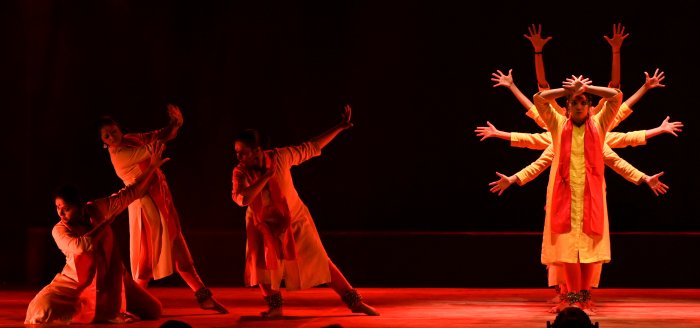 Greeshma 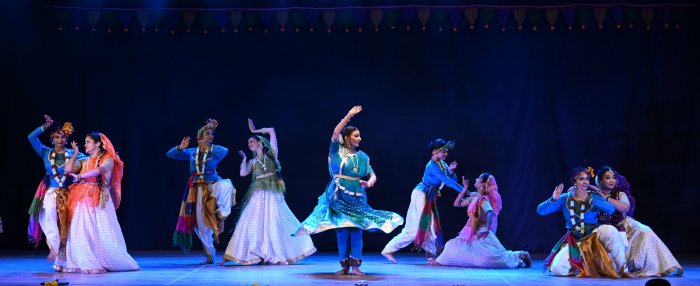 Raas Aabha Wamburkar’s choreography of Raas commenced with her solo portrayal of a Doha – for which her guru Rohini Bhate was well-known – followed by joining of four couples for the celebration of the raas. Known as a brilliant soloist, Rujuta Soman, disciple of Guru Rohini Bhate, has been constantly collaborating with different musical genres in her exploration of choreography. Her collaboration with some of the fabulous musicians like sitarist Purbayana Chatterjee, Rajasthani folk singer Mame Khan and saxophone exponent George Brooks has arrested attention of the Kathak fraternity for her venture with creativity. Khandachapu, her gurudakshina this year, was one such collaboration with famed Carnatic singer Deepika Varadarajan. 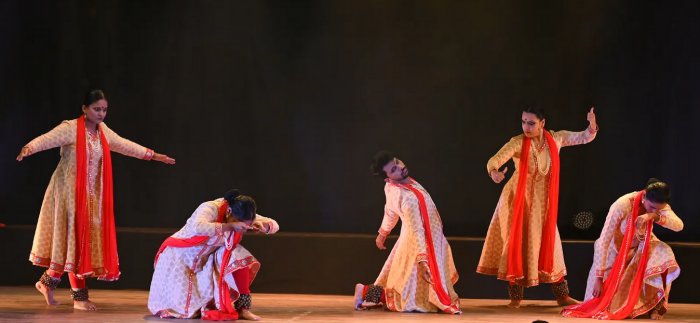 Shivaji Like Lord Ganapati, Chhatrapati Shivaji dwells in and reigns over the hearts of all who belong to Maharashtra. Thus, it was a wise choice by Prajakta Raj, disciple of Guru Rohini Bhate and associate director of her guru’s Nrityabharati Kathak Dance Academy, to choreograph Shivaji as her offering to her guru in Gurudakshina Utsav. Crafted brilliantly in the typical kathakar (story-telling) tradition with short but touching sequences from the life and times of the legendary emperor, the production excelled in all aspects – concept, choreography, music, movements, costume, sound and light. The ten brilliant dancers literally stormed the stage and conquered the hearts of the audience. Eminent Kathak exponent and senior disciple of Rohini Bhate, Guru Roshan Datye’s Nachata Kathak staged as a trio by her Kathak Academy was based on her pathbreaking research on Natyashastra and sculpture. Saadhe Nau Matra (nine and half-beats), one of the fabulous choreographies that the festival witnessed was by Rohini Bhate’s senior disciple Asawaree Patankar. “My guru’s vast array of compositions has some very highly intellectual concept of time-cycles of half beats, such as 6½, 7½, 8½, 10½ and 11½. I was inspired by her to create a time cycle of 9½ beats”, shared the choreographer. The theka for the number has been composed by renowned tabla exponent Pt. Arvind Kumar Azad who was associated with Guru Rohini Bhate for more than 25 years. Manjiri Kiran, Guru Rohini Bhate’s senior disciple, came all the way from the pink city of Jaipur along with disciples to offer her gurudakshina. Living in Rajasthan for more than three decades upon leaving Pune, the unique Dhrupad music tradition of Rajasthan has enriched her vision and creativity as a choreographer. “An artiste from Jaipur, I always longed to create a Kathak piece based on Dhrupad. And I wished to offer it to my guru who always encouraged us to explore beyond the trodden path”, she confided. The future-faces: Disciples of the disciples of Guru Rohini Bhate The festival opened aptly with Nrutya-Vandana, an invocation to the sacred space of stage and Ganesha, Saraswati, Shiva – the gods and goddess associated with dance. Such offer of obeisance is usual to start with a classical dance recital. However, what was unusual and heart-touching was placing of Guru Rohini Bhate at par with the gods and goddesses in the choreography. Deepti Thakur Dasai, the young choreographer, who is based in Mumbai for the past 13 years as the founder-director of Srujan Kathak Dance Academy, staged the presentation with nine dancers. 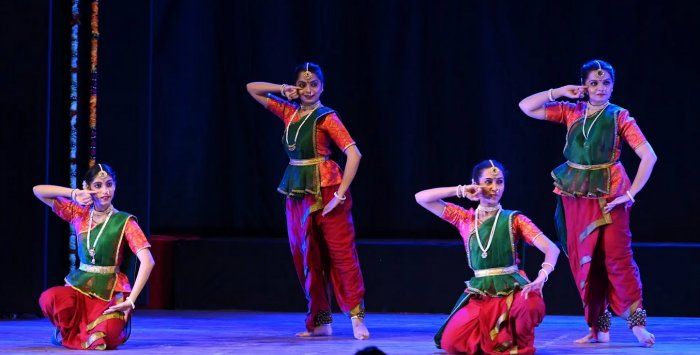 Paanch Gavlan Emerging choreographer Abha Auti, who has explored both the traditional and contemporary contents with equal enthusiasm for her productions like “Dr Meghnath Saha”, a ballet on the life and work of the great Indian astrophysicist Dr. Meghnath Saha, “Soul in exile” on schizophrenia alongside the typical taals, tarana, sargam, chaturang, doha and thumris, choreographed Paanch Gavlan as her gurudakshina that was presented by five dancers including the choreographer. Gavlan, a typical musical pattern based on Marathi folk literature, was set to compositions of Saint Eknath that delineated the five elements of nature, five senses of the body and five colours. In Mayur Shitole's choreography of Uchchista Ganapati, we witnessed a distinctly different treatment of Lord Ganesha in Indian classical dance scenario. It portrayed how Ganesha can be worshipped with a tantric treatment. The choreographer, who is also a gifted dancer, has undertaken a thorough study of the literature and philosophy associated with Ganapati that was evident in the impressive choreography. The lone male dancer in the entire festival, Mayur, who is an IT engineer, has embraced dance as his identity and profession. And in an apt acknowledgement of his devotion to dance and excellence in Kathak, he was conferred the Rohini Bhate Gold Medal Scholarship during the festival. 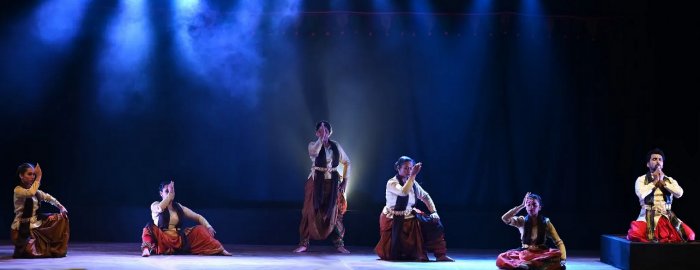 Uchchista Ganapati Dhanashree Natu-Potdar, one of the second-generation choreographers of Guru Rohini Bhate gharana, presented Mandarmala that was based on a song drawn from the immensely popular Marathi musical drama in the same name. It describes the spring season – Ritu Vasant – followed by a tarana set the raag Vasant. Seven budding disciples of young choreographer Ameya Palnitkar presented Ganesh Vandana. Vidula Walwelkar, another choreographer of the second generation, staged Krishna Bhajan set to a Marathi song Dava Nayani Yashodecha Sukumar that delineated the virtues of the playful and mischievous Krishna. Taal Arjun, named after the famed warrior of the Mahabharata who was known for his unmatched speed and focus as an archer, was conceptualized and choreographed by emerging choreographer Kalyani Kulkarni. Brilliantly crafted with a 20-beat rhythmic cycle, it was a pulsating presentation invoking recurrent rounds of applause as it moved from slow to the medium and finally culminating in a fast tempo. Both as a gifted young dancer, teacher and promising choreographer, Venu Riswadkar proved her talent in the festival. Her choreography - Tarana – staged by nine budding and polished dancers was set to a composition by eminent musician Veena Sahastrabuddhe in raag Shuddh-Sarang. Shrungali Paranjape, another young choreographer, presented Shri Ram Bhajan along with her students. The Tulsidas bhajan, made immensely popular by legendary Lata Mangeshkar - Shri Ramachandra Kripalu Bhajaman Haran Bhavbhaya Darunam – penned using Sanskrit, Awadhi and Braj languages, was set to raag Yaman Kalyan. Young choreographer Aditi Riswadkar’s Trivat was based on the unique style in Hindustani classical music genre where the syllables of the pakhawaj are incorporated into a tarana. The singer recites these rhythmic patterns in various tempos creating a captivating experience. Aditi’s Trivat was set to raag Puriya. 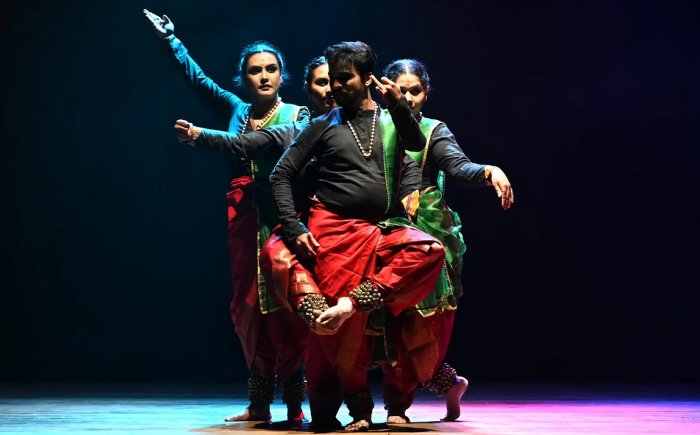 Shikhandi The magnum opus of the two-day festival was immensely promising choreographer Siddhi Abhay’s Shikhandi. The peerless production explores the confusion of this unique character from the Mahabharata about his existence, his fear, his anger towards himself, and eventually his journey towards self-acceptance. It was a classic confluence of the contemporary and the traditional idiom of Kathak weaved into a power-packed presentation enacted by four fabulous dancers including the choreographer. Siddhi could be safely claimed as the find-of-the-festival this year that features choreographers who follow the legacy of the iconic Guru Rohini Bhate. Just 28, she started her brush with choreography at the tender age of 18 as an associate of her mother-guru-mentor Maneesha Abhay. With a bachelor’s degree in German and double masters in Kathak and psychology, her first individual work was a solo choreography on a German poem Margaret Spinard that was performed at a film festival. And there has not been any looking back since then. Gurupujan in absentia  Gurupujan A huge framed photograph of Guru Rohini Bhate was placed on the centre of the stage where the disciples used to make her sit on a chair and offer their puja (worship) during the annual Gurudakshina Utsav. The scene and sentiment of the tradition were recreated as the 11 guru-bhaginis (all direct disciples of the guru) conducted the gurupujan ceremony reciting the Adi Shankaracharya Sanskrit sloka Guru Brahma Guru Vishnu Gurudeva Maheswara. “We still believe that she is with us and in us with her guidance and blessings even though she has left us physically”, Nrityabharati head and festival curator Neelima Adhye shared in an emotion choked voice. Celebration of creativity Guru Rohini Bhate’s Nrityabharati Kathak Dance Academy is as old as independent India – it was born in 1947. Seventy-seven years later, one wonders, how many choreographies must have been created through this annual gurudakshina dance festival! How visionary was the great guru who ‘demanded’ creativity from her disciples and followers of her legacy as her guru-dakshina! “For the Self, selflessly” – reads the last statement in Laheja, the film made on Guru Rohini Bhate. How aptly does it apply to her! 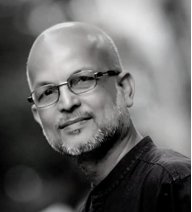 A former journalist and arts critic with Indian Express and The Hindu for nearly 25 years, Shyamhari Chakra is a New Delhi based freelancer who writes on culture. |